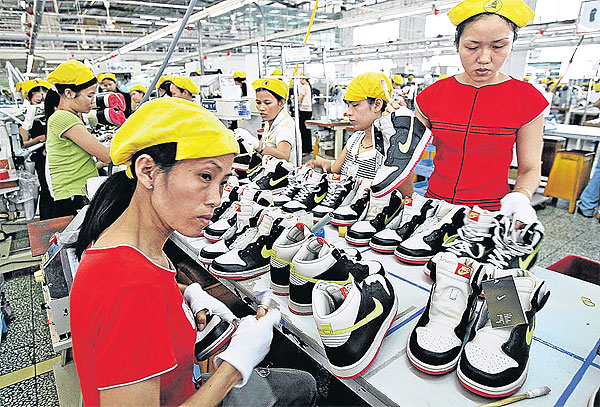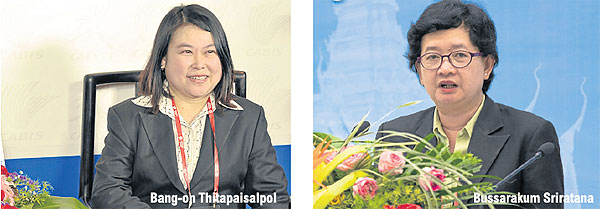As the ‘factory of the world’ faces rising labour and production costs, Chinese companies are taking a closer look at Asean and Thailand.
Oct 29, 2012
Bangkok Post
Bangkok Post
Thailand and Southeast Asian countries continue
to be a magnet for investment by Chinese companies thanks to the growth
prospects of the region and the imminent formation of the Asean
Economic Community (AEC).
 Vietnam overtook China to become the largest producer of Nike shoes in 2010.
Vietnam overtook China to become the largest producer of Nike shoes in 2010.She said there were many reasons for the trend but one of the biggest
advantages Thailand has is its location in the centre of Asean, where new rail and road links would help make Thailand the logistics centre of the region.
Asean, which currently has about 600 million people and trade valued in excess of $2 trillion, has seen its role gradually rise among Chinese investors, who have either used the region as the source for materials for their manufacturing sector or as export markets for processed goods.
This has prompted a surge in two-way trade between China and Asean which hit a new high last year, reflecting the gains made under free trade agreement that took effect in 2010 between Asean and the world’s second largest economy.

Under the FTA, the average tariff on goods from Asean countries to China has been reduced to 0.1% from 9.8%.
Apart from this, there has been a gradual shift of production bases from China to Asean nations over the past few months in response to rising wages at home. As a result, some Asean members have started to take China’s place as the “world’s factory”. Vietnam is a good example, usurping China to become the largest producer of Nike shoes in 2010.
In July, the sportswear giant Adidas said it would close its only affiliated factory in Jiangsu province, with plans to relocate the factory to Myanmar.
Research by the United Nations Conference on Trade and Development (Unctad) indicates that rising labour and production costs in China have made it less competitive than some Asean economies.
Although Guangdong province is still the world’s biggest manufacturer of computer parts, several electronics companies have moved their factories to Asean countries, Chen Zhihua, president of the Guangdong Computer Vendors’ Chamber of Commerce was quoted by Shanghai Daily recently.
The Unctad investment report stated that $117 billion worth of foreign direct investment went into Southeast Asia in 2011, up 26% annually, while FDI to China rose only 8%.

Research conducted by Unctad this year indicates that multinational corporations believe Indonesia and Thailand have benefited greatly from the relocation of industries there.
Vietnam can speak for the benefits of industrial relocation. After Nike transferred more of its orders to Vietnam, the country saw its manufacturing industry output value increase, as well as an overall industrial upgrade that has allowed it to produce more high-end goods.
“Southeast Asian countries’ lower labour costs and land prices have attracted more overseas and Chinese investors,” said Chen, adding that less trade friction and avoidance of trade barriers also prompted foreign companies to move their factories to Southeast Asia.
Ms Bang-on said that countries such as Thailand could benefit from the shift although some concerns remain about the rising wages and the security of industrial property after the calamitous floods of 2011.
“However, we didn’t see any impact from the inquiries of Chinese investors who are interested in investing in Thailand,” she said.
During the first eight months of this year, Chinese investors submitted 25 applications for investment support for projects worth 14.88 billion baht in total, which was higher than in the same period last year.
Ms Bang-on said that language and transport, two obstacles perceived by Chinese investors in the past, had now started to improve. Student exchange programmes between Thailand and China have been helpful in creating greater communication.
Apart from this, logistics and transport routes in the region have also improved, so these positive factors will help expand two-way trade and investment further, she said.
Bussarakum Sriratana, director of the services and consulting division of the BoI, said that Thailand had high potential to support foreign investors in a lot of industrial fields. Among them are for agriculture and agro-industry, alternative energy, research and development (R&D) business for biotechnology and nanotechnology, molds and dies, software development, automobiles and parts, electronic products and parts, machinery equipment and parts, and high value-added natural rubber products.
Recent data collected by the BoI on Chinese investment in Thailand from 2005-12 showed the total value of the projects was US$4.19 billion. The services sector led in value at $1.32 billion, followed by metal products and machinery ($821.55 million), agriculture and agro-industry ($750.43 million), minerals and ceramics ($729.46 million), chemicals and paper ($316.47 million), electrical and electronic products ($127.59 million) and light industries such as textiles ($117.31 million).
“I think China has high potential to invest in Thailand, especially in five major industries,” said Ms Bussarakum. “They are automobiles and auto parts, electronic products and parts, machinery equipment and parts, alternative energy and high value-added natural rubber products.
“In these industries, we are confident that we can be a high-potential base for Chinese investors.”
Thailand was the world’s 15th largest automobile producer in 2011 and aims to move into the top 10 by 2015 with total output of 2.43 million units. Of all the tier-1 car and parts companies in Thailand, 54% are foreign majority-owned.
In the electronics and electrical products industry, Thailand is the world’s largest hard disk drive (HDD) producer. The export value of $53.95 billion for all electronic and electrical goods was ranked 24th in the world.
“Our major products in this field are hard disk drives, integrated circuits, televisions and air-conditioners. We also provide strong supporting industries in electrical appliances such as compressors, motors, plastic and metal parts,” Ms Bussarakum said.
Opportunities also exist in machinery and parts although Thailand will remain dependent on foreign industrial machinery in the near term, she added.
“We have high demand for machinery, especially in food and farm machinery, alternative energy, energy conservation equipment, textile machinery, automotive machinery, and for the mold and die industry.”
Thailand is the world’s largest producer of rubber but only 10% of the natural rubber produced in Thailand has been utilised as a raw material for value-added production.
Rubber exports last year were worth 397.07 billion baht, the fifth highest-value export category. China was the largest export market for Thai rubber with a total value of $4.94 billion.
“We would like to see more Chinese enterprises set up value-added processing for rubber products in Thailand,” Ms Bussarakum said.



No comments:
Post a Comment